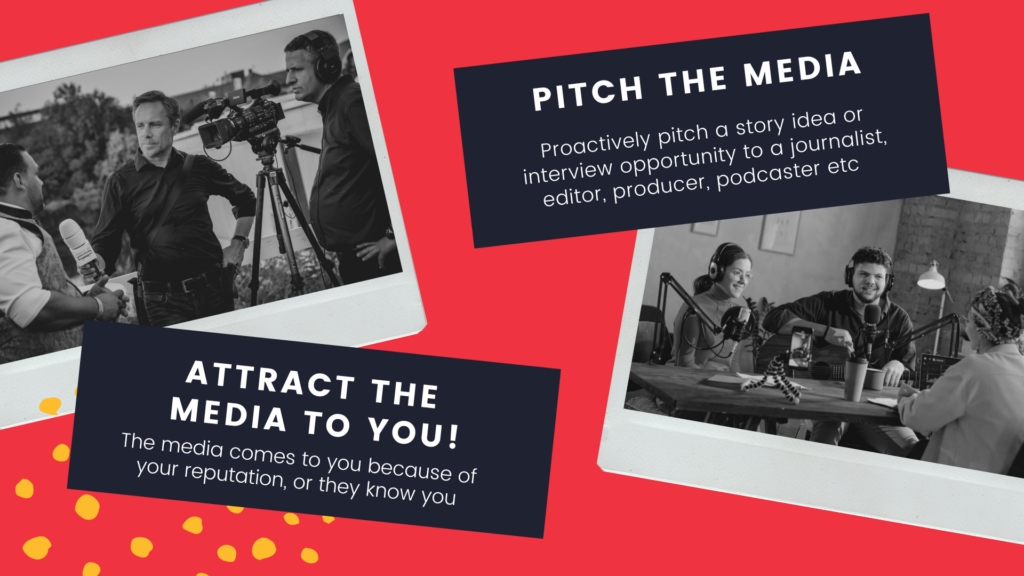Having worked in the public relations industry for over 30 years, I’ve literally lost count of the number of times I’ve had to temper clients’ expectations as to the type of media coverage they could expect to generate for their personal or business brand.
While the media landscape has irrevocably changed over the past 10-15 years, the expectation some people have of achieving sustained ‘A grade’ editorial exposure in key media outlets still exists.
Sometimes, people genuinely have a strong enough hook or story angle that’s good enough to carry through into the mainstream media. But as a rule, it takes time, effort and planning to build up a solid media profile in a way that’s strategic and sustainable.
And that’s what we’re after, right? It’s a waste of time becoming a ‘one-hit media wonder’ – the goal is to build your media presence in a thoughtful and purposeful way so that it contributes positively to your brand and your business.
For the purposes of this article, I’m focusing solely on professional experts and thought leaders, and what they can do to extend the reach of their voice via the media.
Explosion of media outlets
In the micro-presentation video above, I discuss how to generate media exposure for your business or personal brand using what I call the rolling thunder strategy.
If we want to take things up a notch or two with our PR and marketing … if we want to generate attention for our personal brand or service-based business … if we want to position ourselves as the go-to thought leader or expert in our space … then building a profile through meaningful media exposure can really move things along.
But there’s a bit to consider and you want be smart with how you go about it.
First thing to consider is the sheer number of media outlets that exist today, thanks to the emergence of online publishing technologies and the social web. The media has splintered into countless directions; what constitutes media today versus 10 years ago represents ‘chalk and cheese’.
Yes, we still have the mainstream media titles and outlets – radio, TV, newspapers, magazines, albeit they’ve largely shrunk in size and influence in recent years.
Then we have vertical titles that are more niche, for example, publications that service a particular industry (e.g. B&T Magazine) or a broader category (e.g. Management Today) .
Throw into the mix the plethora of blogs and podcasts that are run by both individuals and brands, plus an assortment of digital TV networks (e.g. Ticker News) that are now a thing in most countries.
So, we’ve experienced an explosion of media outlets, and that’s not going to change. On the plus side, this provides entrepreneurs and thought leaders with heaps of opportunities!
But here’s the reality …
Trying to score coverage in many of the tier one mainstream media outlets can be a tough ask, especially if you have little public profile to speak of. It’s not impossible, of course, but it is difficult to achieve on an ongoing basis, unless you have an almighty story or news hook on a hot topic that can pave the way for you.
By all means: THINK BIG – but my pragmatic recommendation is to narrow your focus and to go small, particularly if you’re wanting to position yourself as a thought leader or an expert in your field of endeavour.

Rolling thunder strategy
This is where the rolling thunder strategy comes in. It represents a steady build-up of activity, starting lower down the media food chain and then methodically working one’s way up to the more influential, established print titles, TV shows or radio programs (if, of course, it makes sense to hit these latter outlets – in some cases, the mainstream media is probably a waste of time, but getting into some prestigious business publication might be more the order of the day).
The mantra that underpins the rolling thunder strategy is this: Don’t try and reach for the stars straight away in terms of approaching the media.
Instead, lower your eyes: aim small and start pitching niche outlets such as specialist blogs and online publications, podcasts, community radio or TV, industry association newsletters etc. Speaking gigs at small industry events and community meetups can also be useful.
In terms of blogs, these may be run by passionate individuals, or businesses large and small.
Hybrid media
And then we have what’s known as ‘hybrid media’. These are industry-specific blogs and publications that are quite small operations run by people who often have a media background; they’re commercial entities and are out to make a profit, but are run on the smell of an oily rag. They often need a steady stream of daily content – news stories and opinion pieces etc – but because don’t have enough writers on staff to produce it all, they rely heavily on outside contributors, specifically experts and industry commentators.
Identifying the hybrid media outlets that cover your industry or field of expertise would be a terrific first step on your journey to editorial exposure!
I’d also add podcasts into that ‘first step’ mix because there are a lot of them, and they’re often run by time-stretched individuals who are always looking for interesting guests to interview. Try a podcast database like Podseeker to narrow the field of options!
I know quite a few thought leaders who are taking advantage of the podcast guesting opportunity with great results. For example, Oscar Trimboli.

Build … build … build …
So what we’re you’re trying to do with the rolling thunder strategy is to go small, go niche, and then build up the levels of exposure we can generate for our business and personal brand.
Build your bank of media coverage!
Leverage media mentions through your social channels, and on your website or your blog …
Build it up.
Build it up.
Build it up!
So then, if and when the big opportunity does come up to pitch the higher level prestigious (mainstream) media outlets, you are in a much better position to do so.
Remember, journalists and producers will check you out; seeing that you’ve steadily been working your way up the media chain will give them a degree of confidence.
Speaking of confidence, starting small with the more niche publications and podcasts will help build your own confidence in terms of being interviewed, thinking on your feet, and delivering value in the form of stories, perspectives and opinions on key topics. Oh, and add into the mix developing your skills in coming up with interesting story hooks, angles and interview ideas – very important!
Ongoing editorial exposure can be a powerful way to supercharge your personal brand. Good luck!
FURTHER LISTENING: How to build a national media profile as the go-to expert in your space: Case study with Jake Moore, ESET UK – episode 211 of the Reputation Revolution podcast.
—————————-
👋 I’m Trevor, experienced content and digital communications strategist, coach and mentor
✅ I help credible business leaders and industry experts elevate their profile, build their reputation and grow their sphere of influence in a way that’s strategic, sustainable … and respectful.
#PersonalBranding #ThoughtLeadership #ContentMarketing #PersonalPR #ReputationRevolution #ReputationEconomy #PRWarrior #CredibleAuthority



Leave a Reply